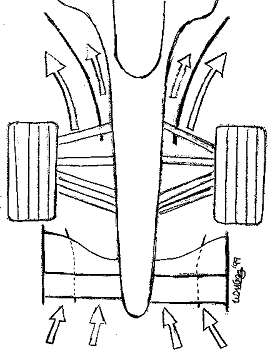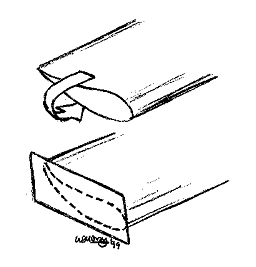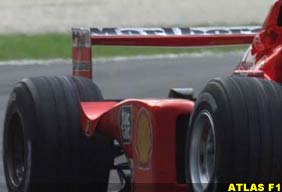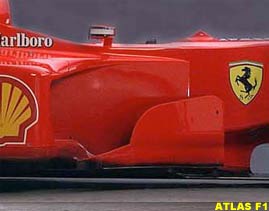|
Atlas F1 presents a series of articles by certified engineer Will Gray, that investigates in greater depth all the technical areas involved in design, development, and construction of a Formula One car. This is the final episode in the series
Final Episode: Aerodynamics Device
The underbody airflow provides the car with a significant amount of downforce. The car will be designed before the start of the year, and the underbody and chassis will generally remain the same for the season.  Nowadays, the teams may have a go at improving the diffuser for the middle of the season, but generally a change in that sort of area is seen as a major effort. However, cars are constantly being developed in other areas, and this section will look at different tricks used now, and in the past, to improve the car's aerodynamics. Nowadays, the teams may have a go at improving the diffuser for the middle of the season, but generally a change in that sort of area is seen as a major effort. However, cars are constantly being developed in other areas, and this section will look at different tricks used now, and in the past, to improve the car's aerodynamics.
Wings are the most important part of the developing aerodynamics - front and rear. Many teams use Computational Fluid Dynamics to develop wing assemblies, and then try the best ones in the tunnel. So it is here that our investigation will begin:
Front Wing:
The front wing is low to the ground to obtain as much advantage from ground effect as possible, and generally has a one full spanning flap. Developments usually concentrate on the profile of the wing, and the use of flaps. However, Ferrari recently angled the leading edge of the wing to form a forward facing V-shape. This comes from flow visualisations on the wing, which shows its suction power is so strong that it pulls air in from angles not straight with the centreline (as shown in the diagram). This means that the air is approaching a normal, straight leading edge at an angle to it, and therefore not working the wing to its full potential. By turning the edge by the correct angle, maximum efficiency will be obtained.
The final part of the front wing assembly, and the part which tends to change most in design, is the endplate. The primary function of this is to stop the high pressure air on the top of the wing from being encouraged to roll over the end of the wing to the low pressure air beneath, thus reducing the effect of the wing. Additionally, they aim to discourage the dirty air created by the front tyre from getting under the floor. They do this by channeling the strong vortex from the wing using scoops and shaping, designed through tunnel testing. Further to these, some teams use 'splitters', which are vertical fences, attached to the undersurface of the front wing, to assist in the job of the endplates. final part of the front wing assembly, and the part which tends to change most in design, is the endplate. The primary function of this is to stop the high pressure air on the top of the wing from being encouraged to roll over the end of the wing to the low pressure air beneath, thus reducing the effect of the wing. Additionally, they aim to discourage the dirty air created by the front tyre from getting under the floor. They do this by channeling the strong vortex from the wing using scoops and shaping, designed through tunnel testing. Further to these, some teams use 'splitters', which are vertical fences, attached to the undersurface of the front wing, to assist in the job of the endplates.
Rear wing:
The rear wing consists of a number of removable elements, connected together by the endplate, and attached to the car by a strong fixing on top of the gearbox. Race engineers can choose the elements they require, but the designers' brief is to fill the rule box for the rear wing as efficiently as possible. The rules show a vertical rectangular box at a point on the car, the view through which must be no more than 70% blocked by the rear wing elements.  By changing wing profiles, designers can obtain different amounts of downforce and drag. If a new profile or combination gives the same downforce for less drag, it is an improvement. By changing wing profiles, designers can obtain different amounts of downforce and drag. If a new profile or combination gives the same downforce for less drag, it is an improvement.
For the wing to work best, it must be positioned in clean air. Obviously, this is difficult, as the air has seen most of the car before it gets to the wing, and the engine cover and cockpit sides provide a serious obstacle to this. In the initial design stage, the engine cover is designed to be as narrow, and the cockpit sides as low as possible. The cockpit area is structurally a roll cage, with a strong point ahead of the cockpit, and the roll hoop above and behind the driver's head. The large side cushions, for safety, are bulky, and create more frontal area on the car - so as frontal area is bad, designers want to make these as low as possible. With the car in side view, the cockpit sides must be a given distance below a line drawn between the front and rear roll structures.  Investigations into reducing their size led to the discovery of a loophole: The much seen 'legality fins', first seen on the 1996 Williams car, mean the rules are satisfied without having high sides. Cheeky! Investigations into reducing their size led to the discovery of a loophole: The much seen 'legality fins', first seen on the 1996 Williams car, mean the rules are satisfied without having high sides. Cheeky!
Other wings:
As wings are a most efficient way of obtaining downforce, designers try to spot loopholes in the rules and find other places to mount the aero devices. In recent years, we have seen extra wings mounted on the engine cover, and on the sidepods - on some ridiculous looking stilts. Both these have now been banned, but one trend still going is winglets. These, positioned in front of the rear tyres, are less efficient as they are close to the body of the car, but are still worth having. However, some teams have two different engine covers, one with winglets for high downforce tracks, and another with flick-ups (ramps where the winglet used to sit, to direct air over the rear wheel) for low downforce circuits.
Barge Boards:
The centre of controversy for 1999, these work at flow regime separation.  They aim to channel the clean air from under the raised nose to the chin and under the car, and send the disturbed air from suspension and wheels around the outside of the sidepod and away from the car. However, some air must be allowed into the sidepods, and that is why the bargeboards are shaped in a triangular form. They aim to channel the clean air from under the raised nose to the chin and under the car, and send the disturbed air from suspension and wheels around the outside of the sidepod and away from the car. However, some air must be allowed into the sidepods, and that is why the bargeboards are shaped in a triangular form.
Suspension:
In recent years, suspension wishbones have been streamlined into an aerofoil shape. They are not, however, allowed to produce downforce, and are simply shaped that way to reduce drag, and keep the flow heading for the chin and the sidepods relatively undisturbed.
Aerodynamic development is often a thankless task. Days spent in the wind tunnel testing part after part in the hope of obtaining mere pounds of downforce can prove a tough job. Even when an improvement is made, it is rarely a notable step, and sometimes may even prove worse when put on the full size car! Less than one in ten parts obtain an improvement - the rest are merely worthy of a place in the dustbin! But if you don't try, you won't get, and the more cash available for aerodynamic advancement, the closer you'll be to that all important win!
Previous Parts in this Series: Parts 1 & 2 | Part 3 | Part 4A | Part 4B | Part 4C | Part 5A | Part 5B | Part 6A | Part 6B | Part 7A | Part 7B-1 | Part 7B-2 | Part 7C
|





